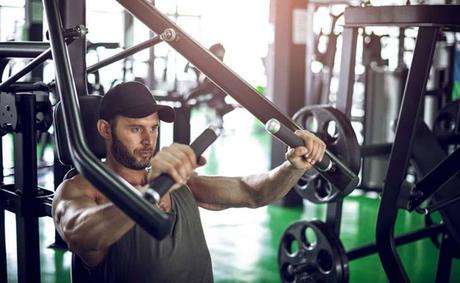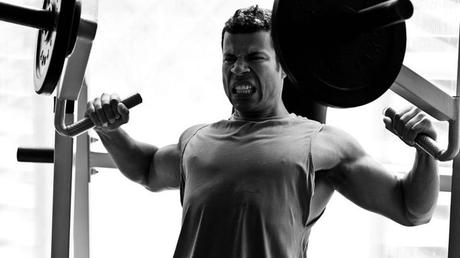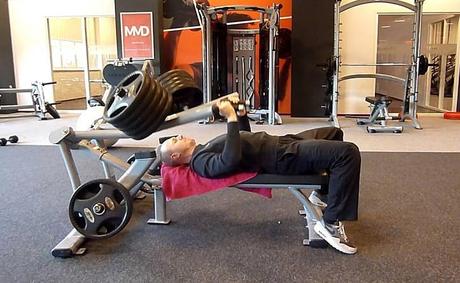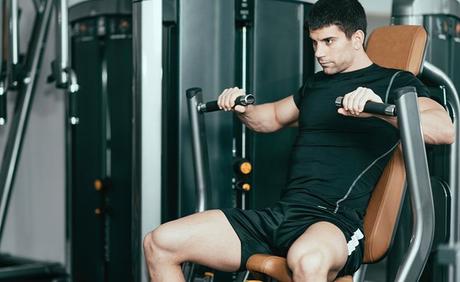Before you hit a skip button, let’s put thing clear: Hammer strength chest press exercise has nothing to do with hammering your chest. No! In fact, the workout doesn’t involve a hammer. So relax! It’s a chest press exercise performed on a weight machine called Hammer strength. So you now know where the word hammer is coming from.
Probably you’ve participated in the never-ending debate in the gyms on whether to use machines in the workouts or free weights. While my side of the fence is the free weight, I still feel that some particular machines can greatly be beneficial to your training in many situations. One of the best machines out there is hammer strength chest press machine found in most gyms.
We have accurately gathered information on hammer strength chest press workout that will help you better understand when to use this type of exercise, why you need it and how to perform the hammer strength chest press workout. In addition, you will learn about the muscles worked and the benefits of this type of workout. I don’t want to pre-empt any information for you, therefore, read on and find out!
When Do You Need To Use the Hammer Strength Chest Press?
Of course, the decision to use hammer strength chest press depends entirely on you. I mean there are no limitations of use, simple! However, we are hereby giving you some tips and suggestions on how to best integrate it in your workouts.
When Injured
Injuries do happen in and out of the gym. However, that doesn’t mean that you throw the towel or wait until you are completely healed from the injury (you will have a lot of work to do when you resume). Hammer strength chest press will help you continue working your chest muscles in a pain-free way. You will not have to use a lot of strength as that involving free weight plates
Fatigued muscles
Beginning with strenuous exercises such as lifting a hefty weight when still fresh, (say early in the morning) seems the best thing to do. Moreover, you can stimulate many muscle fibers and maximize effort without feeling exhausted. However, as you continue adding more weight your muscles will become more fatigued. If you’re using free weight, for example, your stabilizing and supporting muscles will feel very fatigued. Also, your rotator cuff and shoulder muscles will get very tired. These muscles can remain in this state for a long time and hinder chest exercise.
When in such a state, don’t give up your chest training. Instead, embark on hammer strength chest press machine. It’s made in such a way that your stabilizing muscles get less workload. As a result, you can now target your chest without minding the other muscles. In addition, ensure you use hammer strength chest press after using free weight lift, and you are fully exhausted, to help you train your chest.
How Do You Perform A Hammer Strength Chest Press Successfully?

- In this first step, begin by adjusting the seat in a way that the handles rest below your shoulder level when in a seated position. Also, if you wish, you can change the pressure between your chest’s lower and upper portion by raising the seat higher or lower.
- With an underhand grip hold the handles with your two palms (your palm should face downwards). The width of your grip should be in such a way that your wrist and the elbow are in a straight line. Don’t bend your wrist but ensure it remains in a straight position.
- Pull back your blades as you pinch them together. Push them towards the ground. Your chest will be puffed out and the shoulder will then be safe.
- In that position where your shoulder blades are retracted, stretch your arms by straightening them. Your back should be resting flat in the backrest of the machine
- Then gradually, in a controlled manner, return to your starting point and repeat the exercise.
Muscles Worked
The hammer strength chest press is different from the barbell bench press because it strengthens the chest muscles. In addition, it indirectly works the shoulder and triceps muscles. The machine is used to do the pressing movement with an aim of isolating the muscles of the chest from other muscled and working on them. Due to the fixed constant movement pattern, it is easy for you to isolate some muscles. It is a plenty versatile exercise that also engages the triceps, biceps and anterior deltoids. With this exercise, you’re assured a strong upper body.
It is best to add hammer strength chest press workout toward the end of your exercises after doing more compound movements.
Tips to Help You Perform Successfully
- You need to tightly squeeze the handles rather than use a thumbless grip to help improve an incidence called irradiation that aids significant shoulder stability.

- In order for the shoulders to stay safe pinch together the shoulder blades
- Try imagining that instead of pushing the load away from you, you’re the one pushing away from the weight.
- If your shoulder joints hurt (feels pain) at the front, make sure you pull in your shoulder blades. Also ‘pack” your shoulder girdle.
- Without allowing excessive arch from your lower back, retain some tension in some parts of your body such as the abs.
- During the setting stage, maintain the position of, feet on the ground and don’t move your lower body.
- Using the machine variation, most lifters perform the exercise using a thumbless grip because they think that it will help keep tension via the triceps and the pecs instead of squeezing the bar tightly.
- If your local gym has a hammer strength chest press machine, don’t let it be your first exercise. Try workouts such as barbell and dumbbell movements, then finalize your exercises with this one.
Alternative Exercises
Hammer Strength chest press has traditionally been used to work pectorial major, triceps and hosts of stabilizers and helpers such as rotator cuff, pectoris minor rhomboids, and upper trapezius. However, if you reach a state of plateau or for some reasons you can’t use it any more that’s when you look at its variations with respect.
Note: Not all of them will work out well for you. However, at least some will. Try each one of them until you hit the best.
Traditional Supine Bench Press with Olympic bar

How to:
Lie down on a bench with your back flat facing directly under the bar. Hold it away shoulder-width apart. Curve your back a little to make the lower part off the bench while pulling the shoulder blades together. Breathe in as you raise the bar from the rack. With your hands straight, (but avoid locking the elbow) lower it to your sternum. Wait until it touches your body, then put your feet in the ground before pushing the bar up. If you are a beginner, it is recommended that you use a spotter on this workout or some heavy weight. Your feet should remain on the floor and don’t collapse the arch on your back.
Super Band Kettlebell Chest Press
The muscles worked in this exercise are deltoids, triceps and pectorials. Your chest’s smaller stabilizing muscles are also worked.
How to:
Grasp two super bands as well as a heavy kettlebells. Rack a barbell as you half hold the band before looping it via one of the kettlebell handles. Then hook the loops of the bands on the barbells ends to help suspend the kettlebell away from the bar. Place the other band as you did the first one and put it on the bar’s other end. Now carefully raise the bar. Take care! There will be many movements from the kettlebells. It will be moving side to side and at times up and down.
Seated Machine Chest Press

How to:
Begin by adjusting the height of the seat. Hold the handles (with an underhand grasp) with hands aligned to the chest and feet flat on the ground. Engage your abs as you sit up straight. Straighten your wrist and push the handles in front until your arms are stretched straight. Avoid locking your elbows. Now gradually return your arms to your chest in a controlled manner.
Dumbbell Flat Bench Press
The muscles worked in this exercise are the pectoralis major, triceps, deltoids and stabilizers. The workout entails your ability to push your upper arm to your upper body. it is best for bulking your chest up.
How to:
Start by sitting on a flat bench right at the front end as you hold a dumbbell on each hand slightly above your knees. Now lie on the bench as you place the dumbbell in such a position that your palms face each other. Then push the dumbbells up one at a time. Hold them before you, shoulder width apart. Your feet should be up on the bench to reduce your lower backs’ hyper-extension. Turn your wrist so that your palms face away as you lower the dumbbells to your chest’s sides in a 90 degree’s angle. Breathe out as you engage your chest muscles in raising the dumbbells up. Lock your arms and squeeze your pecs. Hold on for a few seconds and then in a controlled manner lower it back.
Traditional Cable Crossover

Note: The position you sit on the pulley determines the part of the chest you want to press. For example, if it’s at a high place then you will press the lower pecs. If the pulley is at its lowest place then your upper pecs will be worked. If it’s at shoulder height then the middle pec fiber will get worked.
How to:
Begin by straightening your arms before you as you use a cable crossover unit with hands on the handles. Bend to make your upper body almost parallel to the ground as you keep a lunge position. Your knees should be soft and arms on your sides. Now put your hands together before your abs. Push your elbows backwards past your shoulder as you go back to the starting place. Keep switching sides as you repeat the workout.
Single-Arm Dumbbell Chest Press
The muscles worked in this exercise are core, triceps, deltoids, deep shoulder stabilizers and pectoralis major. It works in a way that as one side does the pressing then the other holds the beginning position and stabilizes. It works each side of your body alternatively even as it targets the chest.
How to:
Lie on the bench as you hold a dumbbell on each hand. Your arms should face away from you. Let one of your hands remain in the starting position as the other extends the dumbbell lifting it up and across your mid-chest. Then lower the dumbbell gradually in a controlled manner to your side. Your elbow should form a 90 degrees angle while at its starting point. Then switch sides and repeat the exercise. Keep alternating.
Bottom Line
Hammer strength chest press exercise in an excellent workout that targets your chest muscles. However, it should be integrated in your other exercises and given the last part, when you are already exhausted but have to work your chest muscles. In addition, if for some reasons, such as fatigue or injury, you can’t perform, then you can opt to select one of the alternatives as discussed above.
